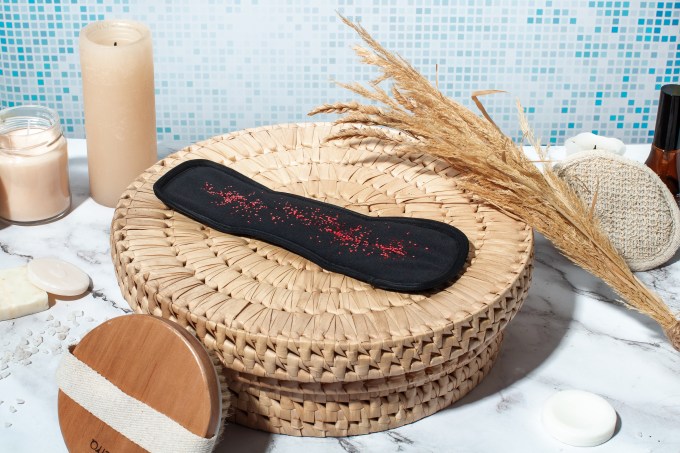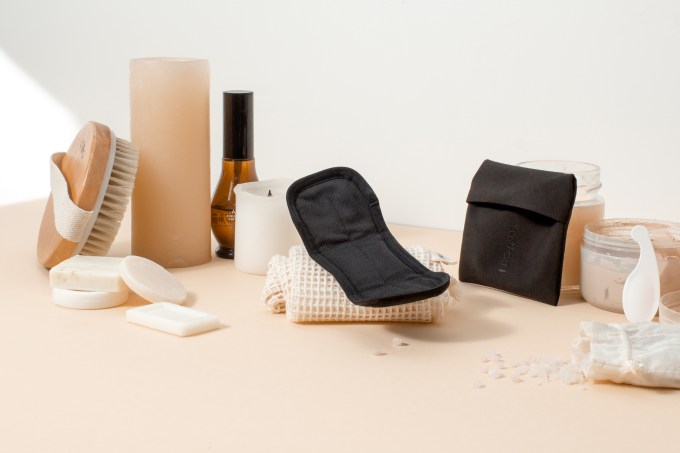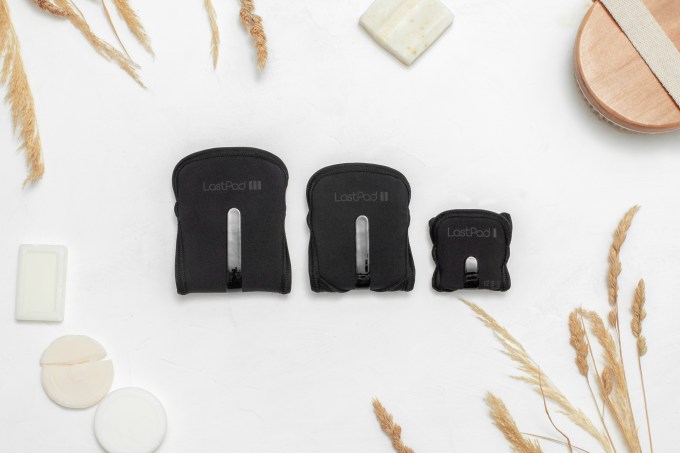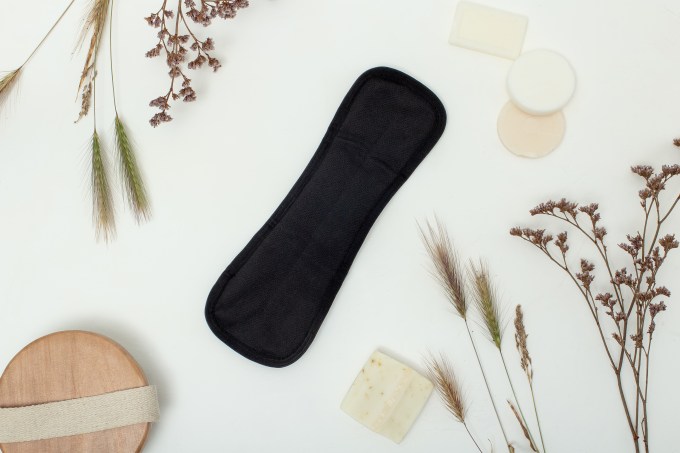Direct to consumer online sales have helped a number of female-focused startups get products to market in recent years — often pitching better designed and generally more thoughtful feminine hygiene products than mainstream staples.
The lack of innovation in the mainstream market for feminine hygiene has certainly created a gap for startups to address. Examples in recent years include companies like Thinx (absorbent panties for menstruation) and Flex (a disc-shaped tampon alternative for wearing during sex). Or Daye — which makes CBD tampons for simultaneously treating period cramps.
Even so, there still hasn’t been a critical mass of product innovation in the category — to the point where alternatives can trickle down (no pun intended) and influence the trajectory of the mainstream market. The core products on shelves are, all too often, depressingly familiar — disposable pads and tampons — even if they may (sometimes) now be made of organic cotton or have some other mild design tweaks.
The most notable change to the available product mix is probably period pants — which have recently started to appear on mainstream shop shelves and seem to be selling well in markets like the U.K., as The Guardian reported recently.
In the average drug store, the other non-disposable alternative you’ll most likely see is the menstrual cup. Which is not at all new — but has finally got traction beyond its original (very) niche community of users, which is another signal that consumers are more open to trying different solutions to deal with their monthly bleeding versus the same old throwaway wadding.
While free bleeding — an old movement which has also seen a bit of wider pickup in recent years — can also be seen, at least in part, as a protest against the poor quality of mainstream products for periods.
All of which makes this forthcoming product launch rather interesting: Meet LastPad, a reusable (rather than disposable) sanitary towel.

Image Credits: LastPad
The first thing you’ll likely notice is that the pad is black in color — which certainly rings the changes versus the usual white stick-on fodder. The company behind LastPad says it worked with an unnamed “luxury lingerie manufacture” on look and feel — and, well, judging by the product shots alone it shows.
The bigger behind-the-scenes change is that it’s been designed for sustained, repeat usage. So each LastPad comes with its own fabric pouch (in a range of colors) for folding up and storing after use (and until you get a chance to pop it in the wash). The pad can also stay in its pouch for washing so there’s no need for additional handling until you’re getting it out of the washing machine to dry.
LastPad is the brainchild of Danish designer and entrepreneur Isabel Aagaard, whose company LastObject has — for the past three years — been taking aim at the wastefulness of single-use hygiene and beauty products, designing reusable alternatives for what are unlovely but practical items — like Q-Tips and tissues*.
In total, LastObject has sold around 1.5 million products so far — across its existing range of beauty, hygiene and travel-focused items. But LastPad marks its first push into a really female-focused product category.
A reusable (washable) sanitary pad is clearly a big step up on the design challenge front versus making reusable (silicone) Q-Tips or (cotton) tissues or makeup rounds — because of the complexity involved with designing a wearable, intimate hygiene product that can handle the variable and often messy nature of periods, and keep doing so, use after use.
It needs to be both comfortable and reliable — as so many disposable pads actually aren’t.
So it’s not too surprising that, per Aagaard, the company has been working on designing and prototyping LastPad for two years. Now they’re finally ready to bring it to market — launching the LastPad on Kickstarter today — with a goal of shipping to early backers next February.
“We’re seeing amazing conversions [for the LastPad pre-campaign],” she says, discussing how much demand they’re expecting. “This is our sixth [crowdfunder] campaign — and it’s looking really good. So I think the demand is bigger than I actually imagined. Because this is also the first product that is only for women. And we were very much in doubt that we should put it on Kickstarter because it’s a very male-dominated platform but it’s looking really positive.”
“We already started working on this two years ago so it’s really been a process. And also because we wanted it to be really innovative. Because right now you can see on the market there’ll be pads that are more like home sewn or do it yourself — and we wanted to really make an exclusive, very, very innovative version of that — that has a lot of the benefits that the single-use version has.”

Image Credits: LastPad
Each LastPad is made up of three layers: A woven top to help keep the pad feeling dry against the skin by quickly funnelling menstrual fluids down into — layer two — a central absorbent section (made of bamboo) — which sits above a TPU base to ensure no risk of leaks.
“The first layer is a woven material that is really, really fine — it has a little bit of silver in it so that the odours will disappear. It’s also woven with small funnels so that the blood disappears very quickly into the middle layer — because it’s so important that you’re not like wet. Because that’s awful. So it dries quite quickly when you’re wearing it,” explains Aagaard. “And then the middle layer is 100% bamboo — it’s absorbent like crazy; 40% more absorbent than, for example, cotton. And it also has anti-bacterial properties. And then the bottom layer is a TPU [Thermoplastic Polyurethane] — which is just a leakproof cover; it’s comfortable, it’s not like a plastic bag but it does make sure that you cannot bleed through it.”
While disposable sanitary towels rely on an adhesive layer to enable the consumer fix the pad to their panties, LastPad has to do that a bit differently too given it’ll be going through the wash. So the pads have wings — which wrap around the gusset of the panties and fix together underneath with a (soft) Velcro fastening.
That’s not all: There’s a (sticky) silicone strip running around the back side of the pad which helps prevent it from moving around — and, per Aagaard, will happily survive repeat washing (in fact if it’s not used for a time, she says dust may temporarily reduce the stickiness — but says that immediately resolves just by wetting it again).
“Where I felt that we really made a huge difference is that on the back side of the pad — it has wings [with] a Velcro [fastener] that’s completely soft and you don’t feel it; even if you’re biking — that was like the big test — and then it has a silicone strip in the back and at the bottom, like a sticky silicone… so it doesn’t move around in your pants.”
Practically speaking, it won’t be possible for a LastPad user to use just one LastPad to see them through their period — given the need to wash and dry them between uses. So a pack of several reusable pads will be necessary to entirely replace disposable pads and ensure there’s always a clean towel available to swap out the used pad.
But LastObject’s idea is, much like you own several pairs of socks and briefs, you’ll have a set of LastPads to see you through until after laundry day.
The product comes in three different sizes and thicknesses to cater to different flow levels, too. So the consumer may end up owning a range of reusable LastPads — from a panty liner option to a day flow and heavier-duty night pads.

Image Credits: LastPad
“It wasn’t as simple as I thought it was going to be — but that’s also because you have to understand the viscoses of blood, for example, compared to water,” Aagaard tells TechCrunch. “And also a flow — it’s not just blood. There’s a lot of other stuff that come out. So it’s taking all of these things into consideration.”
“We’ve been testing it for so long,” she goes on. “That was our main thing with this product. A lot of the other [LastObject products] were very much about printing it, looking at it. Using it of course — but it took us long before we had it in actually a silicone form. Because that is also expensive. Whereas [LastPad] we could sew quite quickly just here at the office and [test it]… So we’ve just been testing it constantly — how’s the feeling? Getting it out to a lot of different women that wear different panties that have different cycles. So it’s really been about testing.”
Pricing for LastPad will be around $60 for three pads — so around $20 per pad. Which is obviously a lot more expensive than the per unit cost of disposable towels. But LastObject says it will offer packs so if a consumer buys more pads it should shrink the per pad cost a little.
Aagaard says the product has been tested to withstand at least 240 washes — which she suggests will mean it’s able to last at least a couple of years, saving likely hundreds of disposable pads from being consumed in its stead.
Although it’s maybe less likely to save consumers money — depending on which disposable pads you’d buy and how many you’d used per cycle (basic disposable pads can cost as little as ~20c each) — as LastObject recommends owning nine of its LastPads which could cost around $80 or more). But the target user is evidently someone with enough disposable income to be able to pay a premium for an eco alternative.
Given the price-point, it does also look more expensive than the menstrual cup — an existing and highly practical alternative to disposable menstrual products — which can cost around $30 (for one reusable cup; and you can get away with owning just one) and, typically, a cup will also last for years as it’s made of silicone.
However the menstrual cup won’t suit every woman — and does require access to clean water to rinse and sanitize — so having more non-disposable alternatives for periods is great.
Aagaard says she’s a fan of the menstrual cup but suggests LastPad can still be useful for its users as a back-up to catch any leaks and/or provide an added layer of reassurance.
While, with period pants, she says the issue she finds unpleasant is the feeling of wetness when wearing them.
On LastPad’s environmental credentials, the washing process required to keep reusing the pad does obviously require some resources (water, soap etc.) but — as is the case with other LastObject products — the company’s claim is that it’s still substantially greener to wash and reuse its non-disposable products versus consuming and binning single-use items that have to be continually produced and shipped out (generating ongoing CO2). Such products can also pollute the environment after they’ve been thrown away — and plastic waste is of course a huge global problem (including from thrown-away sanitary products).
LastObject will be publishing a third-party LCA (lifecycle assessment) for LastPad to back up its eco claims for the reusable product — comparing it to using disposable sanitary pads. But Aagaard is confident it will be substantially better when compared against most disposable alternatives.
“You’ll be putting a wash on anyway; [LastPads] don’t take up that much space; you’re not going to wash them just them; it is with your other laundry; and if you wash them at a cold wash I think that the LCA report will look really good,” she suggests when we ask about the eco credentials.
“We’re doing this with all our products where we’re taking them through a third party who’s testing everything and putting them up against [alternatives] and having these considerations with CO2, with water, with chemicals — with the whole pack… So we’ll be doing that more specifically; right now… the alternative of a [disposable] pad — they are so differently produced. It’s crazy. So I could say the worst [for comparative purposes] or I could say the best — and ours is about 12x better than that.”
“When we got the LCA report for the LastTissue and LastSwab they were so much better than I have imagined,” she adds.
From this year the European Union has started banning the sale of some single-use plastic items (such as Q-tips and disposable cutlery) as reducing plastic waste is one of the goals for regional lawmakers. And — globally — regulators are increasingly looking for quick wins to shrink the environmental impact of the fast moving consumer goods market’s long standing love affair with plastic.
But some disposable product categories are simply more essential than others — which makes it hard for lawmakers to just ban plenty of wasteful, polluting products. So developing innovative, reusable alternatives is one way to help lighten the usage load.
“The most sustainable pad that you can ever have is actually the one that you don’t produce but that would just be free bleeding — and I think that 99% of women are not ready for that,” adds Aagaard. “So can we make some solutions on some of the things that we actually have to take care of?”
While LastObject is sticking with Kickstarter to get LastPad to market, Aagaard confirms that once they see how much early adopter demand it’s getting they plan to produce enough to also sell via some of the other outlets where they currently sell their products — such as e-commerce sites like Amazon and of course their own web shop.
So far, the U.S. has been the main market for LastObject’s reusable wares, per Aagaard — which she attributes to mostly using Kickstarter to build a community of users. But she adds that the company is starting to see more traction in Europe as it’s increased the number of regional distributors it works with.
So what’s next for the company after LastPad? The product direction they’ll take is an active discussion, she says.
“We can keep going the beauty way, we can go more personal care but we have to also [not] go in too many directions. I personally have a lot of fun things I want to do in the bathroom still, because I feel like it’s a space where not a lot of designers have actually really been investigating some of the products that we’re using. Both in beauty but also in personal care. Like in the floss and toothbrush but also in diapers and wipes and all of that. So I think that there’s some innovation that could be really fun. But… this one took two years and I’m so happy about the result and I couldn’t have spent two months less on it. Then we wouldn’t have had the solutions that we’ve gotten to. So that feels very important.”

Image Credits: LastPad
*Washable tissues are also of course not new. Indeed, Wikipedia credits the invention of pocket squares to wipe the nose to King Richard II of England who reigned in the 14th century. But the traditional (fabric) handkerchief — which was used, laundered and reused — became yet another casualty of the switch to single-use, disposable, cheap consumer goods that’s since been shown to have such high environmental costs. So perhaps reversing this damaging default will bring more ‘historical product innovation’ back into fashion as societies look to apply a modern ‘circular economy’ lens.
No comments:
Post a Comment